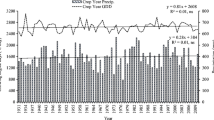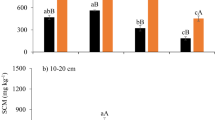Abstract
Novel management practices are needed to increase dryland soil organic matter and crop yields that have been declining due to long-term conventional tillage with spring wheat (Triticum aestivum L.)-fallow system in the northern Great Plains, USA. The effects of tillage, crop rotation, and cultural practice were evaluated on dryland crop biomass (stems + leaves) yield, surface residue, and soil organic C (SOC) and total N (STN) at the 0–20 cm depth in a Williams loam (fine-loamy, mixed, superactive, frigid, Typic Argiustolls) from 2004 to 2007 in eastern Montana, USA. Treatments were two tillage practices [no-tillage (NT) and conventional tillage (CT)], four crop rotations [continuous spring wheat (CW), spring wheat-pea (Pisum sativum L.) (W-P), spring wheat-barley (Hordeum vulgaris L.) hay-pea (W-B-P), and spring wheat-barley hay-corn (Zea mays L.)-pea (W-B-C-P)], and two cultural practices [regular (conventional seed rates and plant spacing, conventional planting date, broadcast N fertilization, and reduced stubble height) and ecological (variable seed rates and plant spacing, delayed planting, banded N fertilization, and increased stubble height)]. Crop biomass and N content were 4 to 44% greater in W-B-C-P than in CW in 2004 and 2005 and greater in ecological than in regular cultural practice in CT. Soil surface residue amount and C and N contents were greater in NT than in CT, greater in CW, W-P, and W-B-C-P than in W-B-P, and greater in 2006 and 2007 than in 2004 and 2005. The SOC and STN concentrations at 0–5 cm were 4 to 6% greater in CW than in W-P or W-B-P in NT and CT from 2005 and 2007. In 2007, SOC content at 10–20 cm was greater in W-P and W-B-P than in W-B-C-P in CT but STN was greater in W-B-P and W-B-C-P than in CW in NT. From 2004 to 2007, SOC and STN concentrations varied at 0–5 cm but increased at 5–20 cm. Diversified crop rotation and delayed planting with higher seed rates and banded N fertilization increased the amount of crop biomass returned to the soil and surface residue C and N. Although no-tillage increased surface residue C and N, continuous nonlegume cropping increased soil C and N levels at the surface layer compared with other crop rotations. Continued return of crop residue from 2004 to 2007 may increase soil C and N levels but long-term studies are needed to better evaluate the effect of management practices on soil C and N levels under dryland cropping systems in the northern Great Plains.
Similar content being viewed by others
References
Aase JK, Pikul JL Jr (1995) Crop and soil response to long-term tillage practices in the northern Great Plains. Agron J 87:652–656
Aase JK, Schaefer GM (1996) Economics of tillage practices and spring wheat and barley crop sequence in northern Great Plains. J Soil Water Conserv 51:167–170
Anderson RL (2000) A cultural system approach can eliminate herbicide need in semiarid proso millet (Panicum miliaceum L.). Weed Technol 14:602–607
Bauer A, Black AL (1994) Quantification of the effect of soil organic matter content on soil productivity. Soil Sci Soc Am J 58:185–193
Black AL, Tanaka DL (1997) A conservation tillage cropping system study in the northern Great Plains of the United States. In: Paul EA (ed) Soil organic matter in temperate agroecosystems: Long term experiments in North America. CRC, Boca Raton, pp 335–342
Bowman RA, Vigil MF, Nielsen DC, Anderson RL (1999) Soil organic matter changes in intensively cropped dryland systems. Soil Sci Soc Am J 63:186–191
Campbell CA, Brandt SA, Biederbeck VO, Zentner RP, Schnitzer M (1992) Effects of crop rotations and rotation phase on characteristics of soil organic matter in a Dark Brown Chernozemic soil. Can J Soil Sci 72:403–416
Dhuyvetter KC, Thompson CR, Norwood CA, Halvorson AD (1996) Economics of dryland cropping systems in the Great Plains. A review. J Prod Agric 9:216–222
Entz MH, Baron VS, Carr PM, Meyer DW, Smith SR Jr, McCaughey WP (2002) Potential of forages to diversify cropping systems in the northern Great Plains. Agron J 94:240–250
Fenster C R, Owens HI, Follett RH (1977) Conservation tillage for wheat in the Great Plains. USDA Ext. Serv. Bull. PA-1190. U.S. Govt. Print. Office, Washington, D.C.
Franzluebbers AJ, Hons FM, Zuberer DA (1995) Soil organic carbon, microbial biomass, and mineralizable carbon and nitrogen in sorghum. Soil Sci Soc Am J 59:460–466
Fryrear DW (1985) Soil cover and wind erosion. Trans ASAE 28:781–784
Gregory PJ, Ingram JSI, Anderson R, Betts RA, Brovkin V, Chase TN, Grace PR, Gray AJ, Hamilton N, Hardy TB, Howden SM, Jenkins A, Meybeck M, Olsson M, Ortiz-Montasterio I, Palm CA, Payn TW, Rummukainen M, Schulze RE, Thiem M, Valentin C, Wikinson MJ (2002) Environmental consequences of alternative practices for intensifying crop production. Agric Ecosys Environ 88:279–290
Haas HJ, Willis WO, Bond JJ (1974) Summer fallow in the western United States. In: USDA Cons. Res. Rep. No. 17. pp 2–35. U.S. Govt. Print. Office, Washington, D.C.
Halvorson AD, Peterson GA, Reule CA (2002a) Tillage system and crop rotation effects on dryland crop yields and soil carbon in the central Great Plains. Agron J 94:1429–1436
Halvorson AD, Wienhold BJ, Black AL (2002b) Tillage, nitrogen, and cropping system effects on soil carbon sequestration. Soil Sci Soc Am J 66:906–912
Kuo S, Sainju UM, Jellum EJ (1997) Winter cover crop effects on soil organic carbon and carbohydrate. Soil Sci Soc Am J 61:145–152
Lal R, Follett RF, Kimble J (1999) Managing U.S. cropland to sequester carbon in soil. J Soil Water Conserv 53:374–381
Lenssen AW, Johnson GD, Carlson GR (2007a) Cropping sequence and tillage system influences annual crop production and water use in semiarid Montana. Field Crops Res 100:32–43
Lenssen AW, Waddell JT, Johnson GD, Carlson GR (2007b) Diversified cropping systems in semiarid Montana: nitrogen use during drought. Soil Tillage Res 94:362–375
Littell RC, Milliken GA, Stroup WW, Wolfinger RD (1996) SAS system for mixed models. SAS Inst. Inc., Cary
Matson PA, Parton WJ, Power AG, Swift MJ (1997) Agricultural intensification and ecosystem properties. Science 277:504–509
Miller PR, McConkey B, Clayton GW, Brandt SA, Staricka JA, Johnston AM, Lafond GP, Schatz BG, Baltensperger DD, Neill KE (2002) Pulse crop adaptation in the northern Great Plains. Agron J 94:261–272
Nelson DW, Sommers LE (1996) Total carbon, organic carbon, and organic matter. In: Sparks DL et al (ed) Methods of soil analysis. Part 3. Chemical methods, SSSA Book Ser. 5. SSSA, Madison, pp 961–1010
Ortega RA, Peterson GA, Westfall DG (2002) Residue accumulation and changes in soil organic matter as affected by cropping intensity in no-till dryland agroecosystems. Agron J 94:944–954
Paustian K, Andren O, Janzen HH, Lal R, Smith P, Tian G, Tiessen H, Van Noordwijk M, Woomer PL (1997) Agricultural soils as a sink to mitigate CO2 emissions. Soil Use Manage 13:230–244
Peterson GA, Halvorson AD, Havlin JL, Jones OR, Lyon DG, Tanaka DL (1998) Reduced tillage and increasing cropping intensity in the Great Plains conserve soil carbon. Soil Tillage Res 47:207–218
Rasmussen PE, Allmaras RR, Rhoade CR, Roager NC Jr (1980) Crop residue influences on soil carbon and nitrogen in a wheat-fallow system. Soil Sci Soc Am J 44:596–600
Sainju UM, Caesar-TonThat T, Lenssen AW, Evans RG, Kolberg R (2007) Long-term tillage and cropping sequence effects on dryland residue and soil carbon fractions. Soil Sci Soc Am J 71:1730–1739
Sainju UM, Lenssen AW, Caesar-TonThat T, Waddell J (2006) Tillage and crop rotation effects on dryland soil and residue carbon and nitrogen. Soil Sci Soc Am J 70:668–678
Sainju UM, Lenssen AW, Caesar-TonThat T, Evans RG (2009) Dryland crop yields and soil organic matter as influenced by long-term tillage and cropping sequence. Agron J 101:243–251
Schomberg HH, Jones OR (1999) Carbon and nitrogen conservation in dryland tillage and cropping systems. Soil Sci Soc Am J 63:1359–1366
Sherrod LA, Peterson GA, Westfall DG, Ahuja LR (2003) Cropping intensity enhances soil organic carbon and nitrogen in a no-till agroecosystem. Soil Sci Soc Am J 67:1533–1543
Strydhorst SM, King JR, Lopetinsky KH, Harker KN (2008) Weed interference, pulse species, and plant density effects on rotational benefits. Weed Sci 56:249–258
Tanaka DL, Krupinsky JM, Liebig MA, Merrill SD, Ries RE, Hendrickson JR, Johnson HA, Hanson JD (2002) Dynamic cropping systems: an adaptable approach to crop production in the northern Great Plains. Agron J 94:957–961
Vigil MF, Anderson RA, Beard WE (1997) Base temperature growing-degree-hour requirements for emergence of canola. Crop Sci 37:844–849
West TO, Post WM (2002) Soil organic carbon sequestration rates by tillage and crop rotation: a global data analysis. Soil Sci Soc Am J 66:1930–1946
Acknowledgement
We acknowledge the help provided by Mark Gaffri, Michael Johnson, and Rene Francis for field work and Joy Barsotti, Johnny Rieger, and Christopher Russell for soil and residue sampling in the field and analysis in the laboratory.
Author information
Authors and Affiliations
Corresponding author
Additional information
Responsible Editor: Keith Paustian.
Rights and permissions
About this article
Cite this article
Sainju, U.M., Lenssen, A.W., Caesar-TonThat, T. et al. Dryland residue and soil organic matter as influenced by tillage, crop rotation, and cultural practice. Plant Soil 338, 27–41 (2011). https://doi.org/10.1007/s11104-010-0403-5
Received:
Accepted:
Published:
Issue Date:
DOI: https://doi.org/10.1007/s11104-010-0403-5




